Leica X1 - camera review
4. Lens characteristic
Lens
Leica X1 has been equipped with the Leica Elmarit 24 mm f/2.8 Asph. Lens. In combination with a DX size sensor it gives the 61 degree angle of view, equivalent of what we see using a full frame and a lens of 36 mm. The lens consists of 8 elements set in 6 groups. One of the elements has an aspherical shape. Inside we’ll also find a diaphragm of 6 blades that can be operated in the range f/2.8-f/16.
When the camera is powered off, the lens doesn’t take much place and looks like a classic pancake. Unfortunately, after turning the camera on it extends vastly, as the animation below shows.
Please Support UsIf you enjoy our reviews and articles, and you want us to continue our work please, support our website by donating through PayPal. The funds are going to be used for paying our editorial team, renting servers, and equipping our testing studio; only that way we will be able to continue providing you interesting content for free. |
- - - - - - - - - - - - - - - - - - - - - - - - - - - - - - - - - - - - - - - - - - - - - - - -
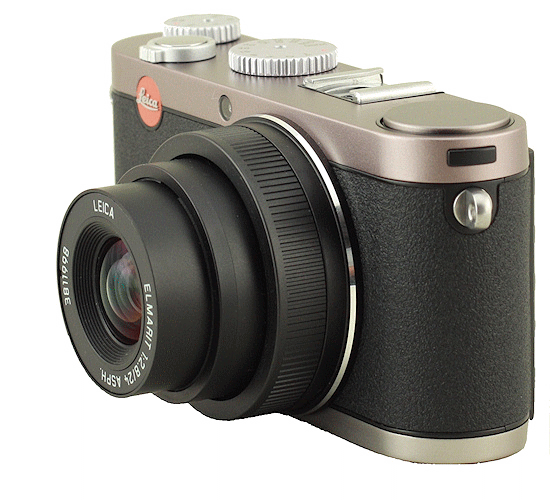 |
It’s too bad Leica didn’t decide to keep the size of a classic pancake also when the camera is on. If Olympus can have 2.8/17 and Panasonic 1.7/20, why can’t Leica? We know this would make the internal construction of the lens more difficult, but if we can’t expect taking up such challenges of Leica, we can’t expect it of anyone.
Image resolution
Just like in our lens reviews, the resolution of Leica X1 has been measured on the strength of RAW files developed without sharpening in dcraw software. The results, in the form of MTF50 values have been measured using Imatest. The measuring errors oscillated between 0.3-1.3 lpmm. The resolution graph both for the center and the edge of the frame is presented below.
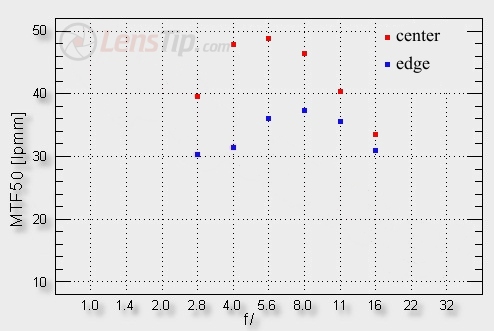
If this were a lens review, it would be hard to complain about anything. At the center of the frame, at the maximum aperture, the lens brushes 40 lpmm – that’s a really high level. After stopping down, we quickly get to maximum values of 48-49 lpmm. These may not be record breaking results for a 12-megapixel sensor, but they’re definitely high and guarantee great sharpness of images.
At the edge of the frame, to say the lens performs well, we require that the lens exceed 30 lpmm. Leica does it. The only thing we may complain about is relatively slow improving of the image quality with stopping down, thus making the difference between the center of the frame and its edge quite large.
Well… Made of plastic Elmerit that’s mounted in the X1 is definitely not a metal Elmarit-M 24 mm f/2.8 Asph. of the M system. The latter costs around 3800 $, so it’s almost twice as expensive as the whole X1.
This subchapter can be summarized quite optimistically for Leica. A person owning Nikon D300/D300s with Nikkor 2.8/24 mounted on it won’t get pictures crispier than an owner of Leica X1. Quite on the opposite, it’s the compact X1 that will win the duel.
Chromatic aberration
Similarly as with resolution, there are basically no reservations about the way Leica’s lens corrects chromatic aberration. The dependence of this aberration on the aperture used is presented in the graph below.
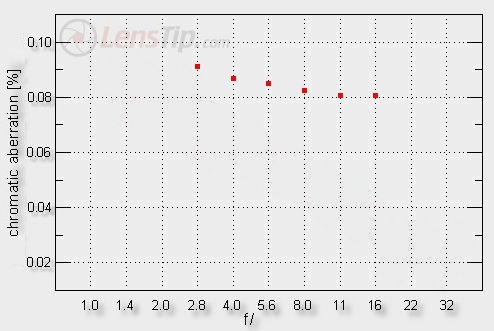
As you can see, chromatic aberration decreases slowly from slightly over 0.09% to 0.08% when going from the maximum aperture to f/16. It’s precisely the borderline between levels low and medium. Thus, in real pictures, chromatic aberration won’t bother us much.
We can once again relate to a set of D300/D300s plus Nikkor 2.8/24. And again, Leica will win this duel, as Nikkor showed chromatic aberration on the levels 0.10-0.18%.
Distortion
Leica X1 has a lens of 24 mm focal length, which on a DX class sensor is the equivalent of 36 mm on a full frame. It is, therefore, a wide-angle lens, which gives us a field of view of 61.1 degrees. Such instruments usually show barrel distortion. E.g. Nikkor 2.8/24, tested on a sensor of the same size, showed distortion of about -1.7%.Sigma 1.8/24 performed slightly better, as its result was -1.46%. In this category, one of Leica’s main competitors took a huge fall. Olympus M. Zuiko 17 mm f/2.8 in combination with E-P1 showed distortion of as much as -5.45%, and it gives a field of view mere 4 degrees wider. How does Leica come off here? Fortunately it’s much close to Nikkor and Sigma than Olympus. In case of X1’s lens we recorder slight barrel distortion that was measured to be -1.60%.
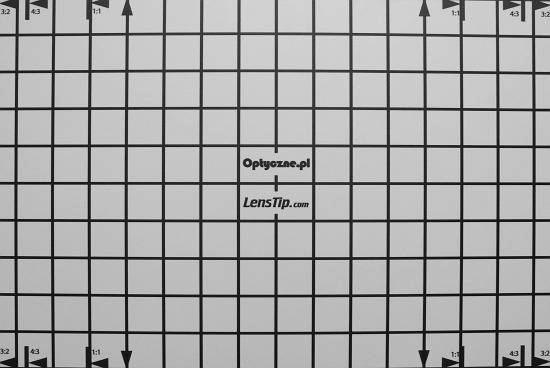 |
Also, it seems that Leica doesn’t correct this aberration via software. First of all, the results turned out to be the same for JPG and DNG files. Second of all, it’s typical for such focal lengths and if it were corrected, it would be much smaller.
Coma and astigmatism
Even though we’re dealing with a Leica lens working on an APS-C/DX sensor, coma is noticeable. Its influence on a circular diode image is perfectly visible at f/2.8 and decreases to a moderate level at f/4.0, which can be distinctly seen on the clippings below. Coma vanishes almost completely at f/5.6.
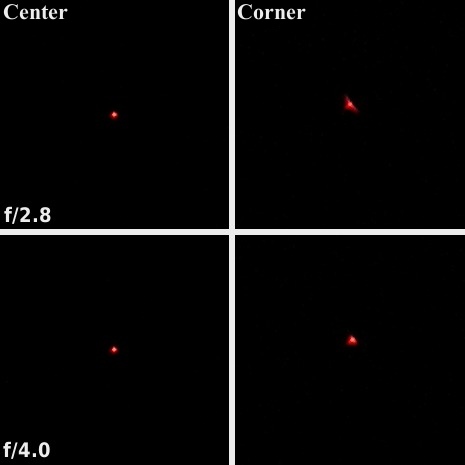
Some fear about the astigmatism levels can be aroused lens’s construction itself. As long as it’s metal when it’s hidden in the camera body, once it extends, we can see a plastic-looking tube. So, even though we’re dealing with a fixed focal length, we have some moving optical elements in its body. We have to trust, then, that in this price Leica didn’t save on the used materials and the plastic is hard and durable. Basically, the low level of astigmatism seems to prove it. It’s 5%, so on the borderline of small and very small values. Thus, we have no reasons to suspect that the movement of optical elements of the system is faulty.
Vignetting
Vignetting is another thing we think is not corrected using camera software as it’s the same for JPG and DNG files.

It won’t bother us much. At the maximum aperture light fall-off in the corners amounted to 19% (-0.62 EV), and stopping down by just one aperture value makes the problem disappear (5%).
We can only praise Leica in this category, even more so, that the M. Zuiko 2.8/17 pancake showed vignetting of 31% (on a small Micro 4/3 sensor) and Nikkor 2.8/24 showed light fall-off in the corners of the frame reaching 23%.
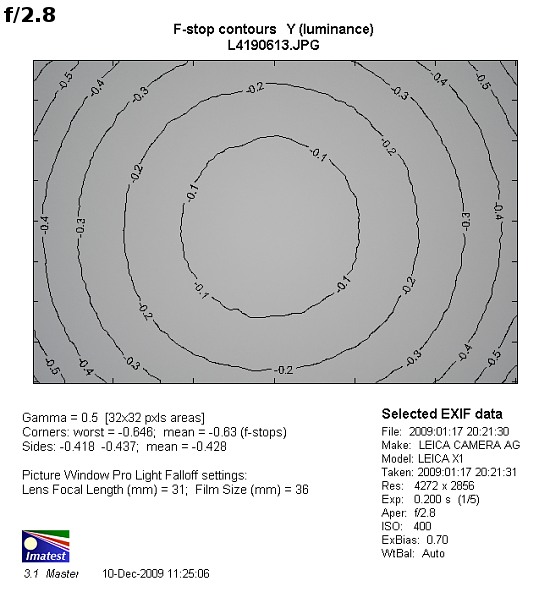 |
Ghosting and flares
Leica’s lens works well against the bright light. Even placing the Sun in on the corners doesn’t make any serious artifact appear. We only managed to catch one visible light artifact, although it wasn’t very bothering. You can see it in the top left hand corner part of the picture.
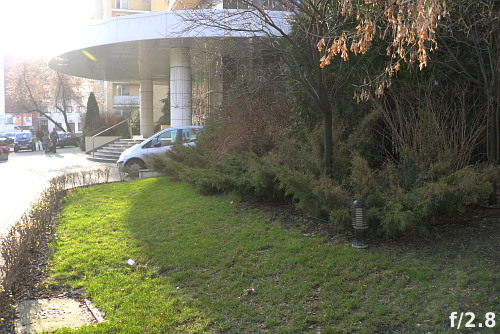 |
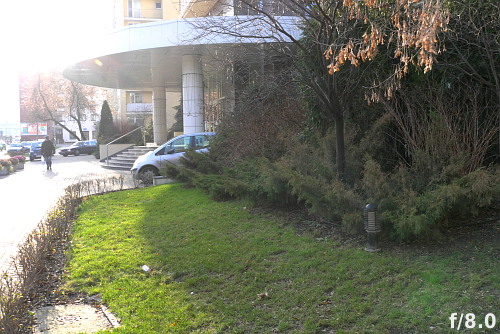 |
Macro
Theoretically Leica X1 has a macro mode. But it’s just theoretically, as it’s far from what some compact cameras focusing right before the front lens can do. The minimum focusing distance for X1 is 30 centimeters from the main plane and 25 centimeters from the front lens. The picture we can take then doesn’t look impressive:
What’s more, the X1 normally works in the range 0.5 meter to infinity. To focus from a smaller distance we need to press AF/MF button on the camera body, and choose “AF Macro” from there. Why such a complication if this macro has nothing to do with real macro? We don’t know. It would be much better to completely resign from this function and allow the X1 to always work in the range 0.3 meter to infinity.
To justify the X1 we have a few facts. Smaller minimum focusing distances of compact cameras are the result of their tiny sensors and very short real focal lengths. Leica X1 has a true, you might say DSLR-like sensor. It’s no wonder, then, that its performance in the macro mode is exactly the same as other 24 mm lenses on APS-C sensors. It’s enough to glance at this table to see that other lenses of this class also focus from 0.25-0.3 meter. Sigma 1.8/24 is a positive exception here, it even gained a Macro in its name thanks to small minimum focal distance.






